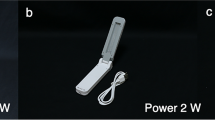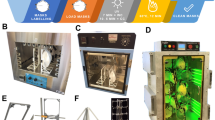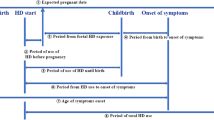Abstract
Objective:
The objective of this study was to test the hypothesis that enhanced ultraviolet germicidal irradiation (eUVGI) installed in our neonatal intensive care unit (NICU) heating ventilation and air conditioning system (HVAC) would decrease HVAC and NICU environment microbes, tracheal colonization and ventilator-associated pneumonia (VAP).
Study
Design:The study was designed as a prospective interventional pre- and post-single-center study. University-affiliated Regional Perinatal Center NICU. Intubated patients in the NICU were evaluated for colonization, and a high-risk sub-population of infants <30 weeks gestation ventilated for ⩾14 days was studied for VAP. eUVGI was installed in the NICU's remote HVACs. The HVACs, NICU environment and intubated patients’ tracheas were cultured pre- and post-eUVGI for 12 months. The high-risk patients were studied for VAP (positive bacterial tracheal culture, increased ventilator support, worsening chest radiograph and ⩾7 days of antibiotics).
Result:
Pseudomonas, Klebsiella, Serratia, Acinetobacter, Staphylococcus aureus and Coagulase-negative Staphylococcus species were cultured from all sites. eUVGI significantly decreased HVAC organisms (baseline 500 000 CFU cm−2; P=0.015) and NICU environmental microbes (P<0.0001). Tracheal microbial loads decreased 45% (P=0.004), and fewer patients became colonized. VAP in the high-risk cohort fell from 74% (n=31) to 39% (n=18), P=0.04. VAP episodes per patient decreased (Control: 1.2 to eUVGI: 0.4; P=0.004), and antibiotic usage was 62% less (P=0.013).
Conclusion:
eUVGI decreased HVAC microbial colonization and was associated with reduced NICU environment and tracheal microbial colonization. Significant reductions in VAP and antibiotic use were also associated with eUVGI in this single-center study. Large randomized multicenter trials are needed.
This is a preview of subscription content, access via your institution
Access options
Subscribe to this journal
Receive 12 print issues and online access
$259.00 per year
only $21.58 per issue
Buy this article
- Purchase on Springer Link
- Instant access to full article PDF
Prices may be subject to local taxes which are calculated during checkout




Similar content being viewed by others
References
Vincent JL, Rello J, Marshall J, Silva E, Anzueto A, Martin CD et al. International study of the prevalence and outcomes of infection in intensive care units. JAMA 2009; 302: 2323–2329.
Srinivasan R, Asselin J, Gildengorin G, Wiener-Kronish J, Flori HR . A prospective study of ventilator-associated pneumonia in children. Pediatrics 2009; 123: 1108–1115.
Opal SM, Calandra T . Antibiotic usage and resistance: gaining or losing ground on infections in critically ill patients? JAMA 2009; 302: 2367–2368.
ASHRAE ASoH, Refrigerating and Air-Conditioning Engineers. ASHRAE Position Document on Airborne Infectious Diseases. Airborne Infectious Diseases Position Document Committee: Atlanta, GA: (www.ashrae.org/positiondocuments) 2009.
Sehulster LM, Chinn RY, Arduino MJ, Carpenter J, Donlan R, Ashford D et al. Guidelines for environmental infection control in health-care facilities. Recommendations from CDC and the Healthcare Infection Control Practices Advisory Committee (HICPAC. American Society for Healthcare Engineering/ American Hospital Association: Chicago IL, 2004.
Brickner PW, Vincent RL, First M, Nardell E, Murray M, Kaufman W . The application of ultraviolet germicidal irradiation to control transmission of airborne disease: bioterrorism counter measure. Public Health Rep 2003; 118: 99–114.
Kumari DN, Haji TC, Keer V, Hawkey PM, Duncanson V, Flower E . Ventilation grilles as a potential source of methicillin-resistant Staphylococcus aureus causing an outbreak in an orthopaedic ward at a district general hospital. J Hosp Infect 1998; 39: 127–133.
Jones AM, Govan JR, Doherty CJ, Dodd ME, Isalska BJ, Stanbridge TN et al. Identification of airborne dissemination of epidemic multiresistant strains of Pseudomonas aeruginosa at a CF centre during a cross infection outbreak. Thorax 2003; 58: 525–527.
McDonald LC, Walker M, Carson L, Arduino M, Aguero SM, Gomez P et al. Outbreak of Acinetobacter spp. bloodstream infections in a nursery associated with contaminated aerosols and air conditioners. Pediatr Infect Dis J 1998; 17: 716–722.
Tellier R . Review of aerosol transmission of influenza A virus. Emerg Infect Dis 2006; 12: 1657–1662.
Li Y, Leung GM, Tang JW, Yang X, Chao CY, Lin JZ et al. Role of ventilation in airborne transmission of infectious agents in the built environment—a multidisciplinary systematic review. Indoor Air 2007; 17: 2–18.
Yu IT, Li Y, Wong TW, Tam W, Chan AT, Lee JH et al. Evidence of airborne transmission of the severe acute respiratory syndrome virus. N Engl J Med 2004; 350: 1731–1739.
Gundermann KO . Spread of microorganisms by air-conditioning systems-especially in hospitals. Ann N Y Acad Sci 1980; 353: 209–217.
Moritz M, Peters H, Nipko B, Ruden H . Capability of air filters to retain airborne bacteria and molds in heating, ventilating and air-conditioning (HVAC) systems. Int J Hyg Environ Health 2001; 203: 401–409.
Holleman-Duray D, Kaupie D, Weiss MG . Heated humidified high-flow nasal cannula: use and a neonatal early extubation protocol. J Perinatol 2007; 27: 776–781.
Foglia E, Meier MD, Elward A . Ventilator-associated pneumonia in neonatal and pediatric intensive care unit patients. Clin Microbiol Rev 2007; 20: 409–425.
Hentschel J, Brungger B, Studi K, Muhlemann K . Prospective surveillance of nosocomial infections in a Swiss NICU: low risk of pneumonia on nasal continuous positive airway pressure? Infection 2005; 33: 350–355.
Apisarnthanarak A, Holzmann-Pazgal G, Hamvas A, Olsen MA, Fraser VJ . Ventilator-associated pneumonia in extremely preterm neonates in a neonatal intensive care unit: characteristics, risk factors, and outcomes. Pediatrics 2003; 112: 1283–1289.
Aly H, Badawy M, El-Kholy A, Nabil R, Mohamed A . Randomized, controlled trial on tracheal colonization of ventilated infants: can gravity prevent ventilator-associated pneumonia? Pediatrics 2008; 122: 770–774.
Goldner JL, Moggio M, Beissinger SF, McCollum DE . Ultraviolet light for the control of airborne bacteria in the operating room. Ann N Y Acad Sci 1980; 353: 271–284.
Sagripanti JL, Lytle CD . Inactivation of influenza virus by solar radiation. Photochem Photobiol 2007; 83: 1278–1282.
Riley RL, Nardell EA . Clearing the air. the theory and application of ultraviolet air disinfection. Am Rev Respir Dis 1989; 139: 1286–1294.
QATT. Support Anti-terrorism by Fostering Effective Technologies Act of 2002 (SAFETY); Qualified Antiterrorism Technology (QATT). Homeland Security Act of 2002 2002; Title VIII, Section 861–862, p 2238.
AIHA. AIHA Field Guide. 1996.
York MK, Gilligan P . Lower respiratory tract cultures In: Isenberg HD (ed). Clinical Microbiology Procedure Handbook, 2nd edn. ASM Press: Washington DC, 2004.
Teresa C. Horan, MPH, Mary Andrus, RN, BA, CIC, Margaret A. Dudeck, MPH . CDC/NHSN surveillance definition of health care-associated infection and criteria for specific types of infections in the acute care setting. Am J Infect Control 2008; 36: 309–332.
Katayama Y, Minami H, Enomoto M, Takano T, Hayashi S, Lee YK . Usefulness of Gram staining of tracheal aspirates in initial therapy for ventilator-associated pneumonia in extremely preterm neonates. J Perinatol 2010; 30: 270–274.
Karlowicz MG, Buescher ES, Surka AE . Fulminant late-onset sepsis in a neonatal intensive care unit, 1988–1997, and the impact of avoiding empiric vancomycin therapy. Pediatrics 2000; 106: 1387–1390.
Langmuir AD . Changing concepts of airborne infection of acute contagious diseases: a reconsideration of classic epidemiologic theories. Ann N Y Acad Sci 1980; 353: 35–44.
Lawrence JC, Lilly HA, Kidson A . Wound dressings and airborne dispersal of bacteria. Lancet 1992; 339: 807.
Hirai Y . Survival of bacteria under dry conditions; from a viewpoint of nosocomial infection. J Hosp Infect 1991; 19: 191–200.
Owen MK, Ensor DS, Sparks LE . Airborne particle sizes and sources found in indoor air. Atmos Environ 1992; 26A: 2149–2162.
Friberg B, Friberg S, Burman LG . Correlation between surface and air counts of particles carrying aerobic bacteria in operating rooms with turbulent ventilation: an experimental study. J Hosp Infect 1999; 42: 61–68.
Adams W, Valence M . Effectiveness of UV lights inside air handling units in reducing airborne bacteria and fungi in hospital operating rooms Abstract, American Industrial Hygiene Association 2008 meeting URL: http://www.aiha.org/education/meetings-conferences/aihce/archivedabstracts/2008abstracts/Documents/08%20Healthcare%20Industries%20-%20Microbial%20Investigations,%20Environmental%20Testing,%20and%20Other%20Topics.pdf, Minneapolis, MN 2008.
Yuan TM, Chen LH, Yu HM . Risk factors and outcomes for ventilator-associated pneumonia in neonatal intensive care unit patients. J Perinat Med 2007; 35: 334–338.
Markowicz P, Wolff M, Djedaini K, Cohen Y, Chastre J, Delclaux C et al. Multicenter prospective study of ventilator-associated pneumonia during acute respiratory distress syndrome. Incidence, prognosis, and risk factors. ARDS Study Group. Am J Respir Crit Care Med 2000; 161: 1942–1948.
Elward AM, Warren DK, Fraser VJ . Ventilator-associated pneumonia in pediatric intensive care unit patients: risk factors and outcomes. Pediatrics 2002; 109: 758–764.
WHO. Avian Influenza, including Influenza A (H5N1), in humans: WHO interim infection control guideline for health care facilities. http://www.wprowhoint/NR/rdonlyres/EA6D9DF3-688D-4316-91DF-5553E7B1DBCD/0/InfectionControlA1inhumansWHOInterimGuidelinesfor2pdf. World Health Organization 2007.
Lockman JL, Fischer WA, Perl TM, Valsamakis A, Nichols DG . The critically ill child with novel H1N1 influenza A: a case series. Pediatr Crit Care Med 2010; 11: 173–178.
Acknowledgements
This work was supported in part by a grant from the NYSTAR Center for Advanced Technology in Biomedical and Bioengineering, by the Department of Pediatrics, SUNY at Buffalo, and by an in-kind contribution of eUVGI technology and installation and environmental sample collection from Vigilair Systems. We acknowledge, Diane Dryja, Director of Kaleida Microbiology Laboratory for culture analysis, Andrea Mattingly, for data base analysis, Sharrie Licata, for guidance on billing, Michele Pamer for computer generated design and the NICU nurses for their invaluable assistance in sample collection.
Author information
Authors and Affiliations
Corresponding author
Ethics declarations
Competing interests
Corinne Leach, MD, PhD, is the spouse of Vigilair Systems stockholder and former CEO (Timothy Leach), and she introduced the concept to our group.
Additional information
Supplementary Information accompanies the paper on the Journal of Perinatology website
Rights and permissions
About this article
Cite this article
Ryan, R., Wilding, G., Wynn, R. et al. Effect of enhanced ultraviolet germicidal irradiation in the heating ventilation and air conditioning system on ventilator-associated pneumonia in a neonatal intensive care unit. J Perinatol 31, 607–614 (2011). https://doi.org/10.1038/jp.2011.16
Received:
Revised:
Accepted:
Published:
Issue Date:
DOI: https://doi.org/10.1038/jp.2011.16
Keywords
This article is cited by
-
Experimentation and Mathematical Modelling of Process Parameters for Prevention of Infectious Disease Caused by Staphylococcus aureus Bacteria in Indoor Environment
Water, Air, & Soil Pollution (2023)
-
Factors Associated With Neonatal Pneumonia and its Mortality in India: A Systematic Review and Meta-Analysis
Indian Pediatrics (2021)
-
Microbial reduction in the NICU: seeing the light
Journal of Perinatology (2011)



